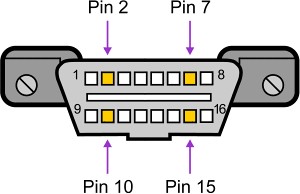Navigating the world of automotive diagnostics can be complex, especially when dealing with older vehicles. If you own a 1999 General Motors (GM) vehicle and are trying to understand its On-Board Diagnostics (OBD2) system, you’re in the right place. This guide will clarify the specifics of 1999 Gm Obd2 compliance, focusing on the connector type and communication protocols you’re likely to encounter.
One of the first steps in determining OBD2 compliance for your 1999 GM vehicle is to locate and examine the diagnostic connector. The OBD2 standard mandates a specific connector type, known as the SAE J1962 connector. This connector is characterized by its 16 pins and trapezoidal shape. Locating this port in your GM vehicle is the initial confirmation that you’re dealing with a system designed to be more standardized than its predecessors.
 SAE J1962 OBD2 Connector Pinout: Inspect the 16-pin layout on your 1999 GM vehicle to confirm OBDII compliance.
SAE J1962 OBD2 Connector Pinout: Inspect the 16-pin layout on your 1999 GM vehicle to confirm OBDII compliance.
Beyond just the connector shape, understanding the pin configuration is crucial, especially when it comes to GM vehicles of this era. In 1999, GM utilized a specific signaling protocol known as J1850 VPW (Variable Pulse Width Modulation). To identify if your 1999 GM vehicle uses this protocol, you can check for metallic pins in specific positions of the OBD2 connector. The J1850 VPW protocol, common in GM vehicles, typically uses pins 2, 4, 5, and 16, but importantly, not pin 10. This pin configuration is a strong indicator of the diagnostic communication protocol your 1999 GM vehicle employs.
While J1850 VPW was prevalent in 1999 GM vehicles, it’s worth noting that other protocols existed and were used by different manufacturers. For example, Ford at the time often used J1850 PWM, which has a slightly different pin configuration, including pin 10. European and Asian manufacturers sometimes utilized ISO 9141-2 KWP2000, which has yet another pin arrangement. However, for a 1999 GM vehicle, J1850 VPW is the most probable protocol.
It’s also important to be aware that even if your 1999 GM vehicle has the correct SAE J1962 connector with the expected pin configuration, it’s not an absolute guarantee of full OBD2 compliance. The automotive industry was in a transitional phase around this time, and some early implementations, sometimes referred to as “OBD 1.5”, existed. These systems might use the OBD2 connector but have limitations compared to fully compliant OBD2 systems.
In conclusion, when diagnosing a 1999 GM vehicle, start by verifying the presence of the SAE J1962 OBD2 connector. Then, check the pin configuration, looking for pins in positions 2, 4, 5, and 16, and the absence of a pin in position 10, which suggests the J1850 VPW protocol. While highly likely to be OBD2 compliant, understanding these specifics will help you choose the correct diagnostic tools and interpret the data accurately for your 1999 GM car.
